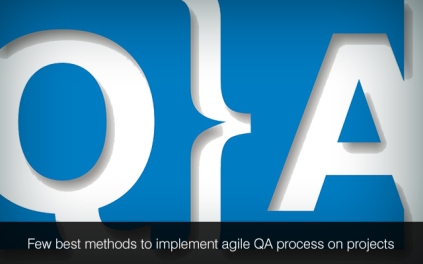Agile QA (Quality Assurance) Process is a procedure of software testing, which follows various principles of agile software development. The practice involves all the members of a cross functional agile development and testing team, with major role played by the testers so as to ensure a seamless delivery of business values desired by the customers concerned at regular intervals.
 Effective Quality Assurance process offers a multitude of benefits, particularly when it comes to bridging the gap between IT and business. However, its benefits cannot be enjoyed to the fullest extent till certain methods are not obtained while implementing the process. Therefore, let us discuss some of the best practices of Agile QA process implementation, especially when it comes to implementing it in any complex environment.
Effective Quality Assurance process offers a multitude of benefits, particularly when it comes to bridging the gap between IT and business. However, its benefits cannot be enjoyed to the fullest extent till certain methods are not obtained while implementing the process. Therefore, let us discuss some of the best practices of Agile QA process implementation, especially when it comes to implementing it in any complex environment.
Giving importance to estimation based on size
Size based estimation has always been one of the most trustworthy as well as tried and tested practices of the environment of conventional software development. However, when it comes to Agile QA process, it mainly uses a comparatively quicker as well as a livelier form of effort estimation that involves multiple sprints. Contracts that involve fixed pricing generally demand the predictability of the techniques of size-based estimation.
The initial cost of the practice is normally based on a higher definition of the expected scope of work or functionality along with the contract, based on the size of the functionality that is to be delivered to the client along with the cost of per unit size. However, to support the character of agile, the actual functionality that is delivered at the end of the day might be different from what was estimated or stipulated.
Effective Specifications
The first and foremost principle of agile testing is that it is basically a futile exercise that is meant to lock down all the requirements in an outright manner. Now, on a number of occasions this phenomenon is used to negate the presence of any ineffective documentation whatsoever. Though ideally it is virtually impossible to document all the requirements straightaway, effective Quality Assurance process needs a rather lightweight, yet highly effective functional design specification.
Close collaboration with stakeholders
It is also imperative that a close collaboration along with the availability of the stakeholders is maintained for carrying out the discussion regarding the project requirements. Delay in clarification of requirements might result in unnecessary strain on the development team due to shortage of sprint time. In case of offshore models, this comes in particularly important as the scope of interaction with the customers get limited due to the difference in time zones as well as the physical or geographical distance between the two sides.
Hence, in these cases the best practice that can be maintained is to have a dedicated team that will take care of designing the user stories from the backlog of the product. This can be done utilizing an initial order of priority and fleshing it out in an ideal factory model, by following a more stringent and at the same time, an upfront schedule of implementation.
Maintaining the right architecture
Architecture is another extremely important factor that poses challenges in an Agile QA process implementation. One of the most common mistakes that people end up doing is ignoring the architecture so as to put more emphasis on satisfying the customer visible functionality. Lack of any feasible architecture ostensibly means that there is every possibility of the subsequent sprint time getting increasingly tight in terms of schedule.
It may also get problematic as well as fragile. Once that happens, the feasibility of the entire project gets affected seriously. Hence, the catch lies in the identification of the user stories that can have an impact on the project architecture and the introduction of the appropriate amount of architecture into the project itself. Again, instead of defining virtually everything straight away, thereby putting an unnecessary strain, it is better to define exactly what is required and leave enough space for subsequent evolution.
Maintenance of a Balanced Team
It is unlikely that each and every member of a large agile development and implementation team will have sizeable experience under his or her belt. The success of a team depends on a number of factors – more specifically, on the right combination of various mechanisms that include the right focus on the architecture, the design factory in question, and last but not the least the right practices and tools of development that are being used. Hence, instead of having a fairly large team it is better to have a relatively small team, which has the right balance and the expertise to come up with the best results.
The Right Strategies
A Quality Assurance process needs to take an E2E (end to end) journey centric point of view or perspective during the sprint planning process and subsequently prioritize the sequence related stories in a perfectly logical order. Placement of the test designers within an agile design factory along with an appropriate coordination between the execution team and the implementation team can facilitate an efficient as well as collaborative Agile Quality Assurance process. This is where the need for implementation of the right strategies lies.
You can hire testers from top manual software testing companies in India who can help you accomplish testing within allocated budgets and time schedules.
We provide qa and testing services. If you would like to hire software testers from us, we would be glad to assist you at Mindfire Solutions.